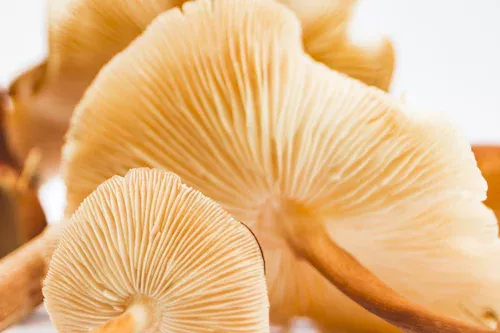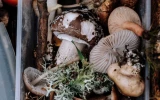How To Make Fertile Mushroom Spawn (the Right Way)
When it comes to growing mushrooms, having a healthy and fertile mushroom spawn is very important. Mushroom spawn is the foundation for growing your mushrooms, and it will determine the success or failure of your mushroom crop. Knowing how to make mushrooms spawn the right way is essential for mushroom growth.
To make fertile mushroom spawn, start by sterilizing grain or sawdust, then inoculate the substrate with mushroom spores or spawn. Incubate in a warm, dark place until the substrate is fully colonized. Once colonized, the spawn can be used to inoculate additional substrates or directly inoculate a fruiting substrate.
This guide will walk you through the step-by-step process of producing mushroom spawn, how to harvest mushroom spawn, its benefits, and its various types.
Summary
- To make fertile mushroom spawn the right way, start by preparing your growing medium, such as sawdust, straw, or grains.
- After sterilization, mix your growing medium with a culture or spores of the mushroom species you want to grow.
- Place the mixture in a container and seal it tightly. Incubate your spawn in a warm, dark place for a few weeks until it is ready to use.

On this page:
Let's Make Fertile Mushroom Spawn the Right Way
Making fertile mushroom spawn involves a few steps that need to be followed carefully. With these steps, you can make your mushrooms spawn the right way. Here's a general outline of the process:
1. Choose your mushroom species in growing a fertile mushroom spawn
Different mushroom species have different requirements for growing, so you'll need to decide which species you want to grow and what substrate you'll be using.
2. Prepare the substrate of your desired mushroom spawn
The substrate is the material that the mushrooms will grow on. This can be a variety of materials, such as sawdust, straw, or composted manure. The substrate needs to be sterilized to kill any unwanted bacteria or fungi.
3. Inoculate the substrate with the mushroom spawn
After the substrate has cooled down, it's time to inoculate it with the mushroom spawn. You can purchase spawn online or make your own using a mushroom culture. Inoculate the substrate with the spawn by mixing it in thoroughly.
4. Incubate the substrate to grow the mycelium for the spawn
Once the substrate has been inoculated, it needs to be kept in a warm, dark place to allow the mycelium to grow. This can take anywhere from a few days to a few weeks, depending on the mushroom species.
5. Allow the spawn to colonize in weeks or months
As the mycelium grows, it will begin to colonize the substrate. This process can take anywhere from a few weeks to a few months, again depending on the species.
6. Prepare the spawn for use
Once the substrate has been fully colonized, it's time to prepare the spawn for use. You can either use it right away or store it in a cool, dry place for later use.

Types of Fertile Mushroom Spawn
There are some of the most common types of fertile mushroom spawn, but many variations and methods can be used depending on the species being cultivated and the resources available. Here are several types of fertile mushroom spawn, each with its advantages and disadvantages:
-
Grain spawn is made by mixing mushroom spores or mycelium with sterilized grains, such as rye, wheat, or millet. It's a popular choice for many mushroom cultivators because it's relatively easy to make and can be used for a wide variety of mushroom species.
-
Sawdust spawn is made by mixing mushroom spores or mycelium with sterilized sawdust. It's often used for species that prefer a wood-based substrate, such as shiitake or oyster mushrooms.
-
Plug spawn is made by inserting small wooden plugs inoculated with mushroom spores or mycelium into a pre-drilled hole in a log or tree stump. It's commonly used for outdoor cultivation of species that grow naturally on wood, such as shiitake and oyster mushrooms.
-
Liquid spawn is made by mixing mushroom spores or mycelium with a nutrient-rich liquid, such as molasses or malt extract. It's a relatively fast method of producing spawn and is often used for species that require liquid or semi-liquid substrates, such as lion's mane or reishi mushrooms.
-
Culture spawn is made by transferring a small piece of mushroom tissue onto a nutrient-rich agar medium, where it grows into mycelium. It's used for creating new strains or starting a new batch of mushroom spawn.
Harvesting Fertile Mushroom Spawn
Harvesting fertile mushroom spawn involves separating the mycelium from the substrate in which it has been growing. Below is a general outline of the process. Remember to practice sterile techniques throughout the entire process to prevent contamination. With a little patience and attention to detail, you can harvest fertile mushroom spawn that will yield a bountiful harvest.
1. Choose the right time to harvest the spawn
You'll want to wait until the mycelium has fully colonized the substrate before harvesting. This can take anywhere from a few weeks to a few months, depending on the species.
2. Prepare your workspace before harvesting
You'll need a clean, sterile workspace to prevent contamination during the harvest. Make sure all equipment and surfaces are thoroughly sanitized.
3. Break up the colonized substrate
Use your hands or a tool to break up the colonized substrate into small pieces.
4. Separate the mycelium from the substrate
Use a screen or mesh to sift out the mycelium from the substrate. You can also use a clean, sharp knife to cut away any remaining substrate.
5. Store the spawn after harvesting
Once you've separated the mycelium, you can use it right away or store it for later use. Store it in a cool, dry place, such as a refrigerator, until you're ready to use it.

Benefits of Fertile Mushroom Spawn
Using fertile mushroom spawn can lead to higher yields, greater control, and more sustainable growing practices. Fertile mushroom spawn has several benefits, including:
-
A fertile mushroom spawn can give you a consistently high-quality mushroom crop. When you use fertile mushroom spawn, you can be sure that the mycelium is healthy and vigorous, which leads to consistent and high-quality mushroom crops.
-
A fertile mushroom spawn is cost-effective. Making your own mushroom spawn is often less expensive than purchasing pre-made spawn. Additionally, you can reuse the spawn for multiple harvests, further reducing costs.
-
A fertile mushroom spawn can give you a sustainable supply. By making your own mushroom spawn, you can reduce your reliance on commercial suppliers, which can be more environmentally sustainable.
-
Having a fertile mushroom spawn can give you greater control over the process. When you make your own mushroom spawn, you have greater control over the process, which allows you to experiment with different substrates and growing conditions to achieve the best possible results.
-
You will have an expanded variety in having a fertile mushroom spawn. With fertile mushroom spawn, you can grow a wider variety of mushrooms than what may be available from commercial suppliers.



